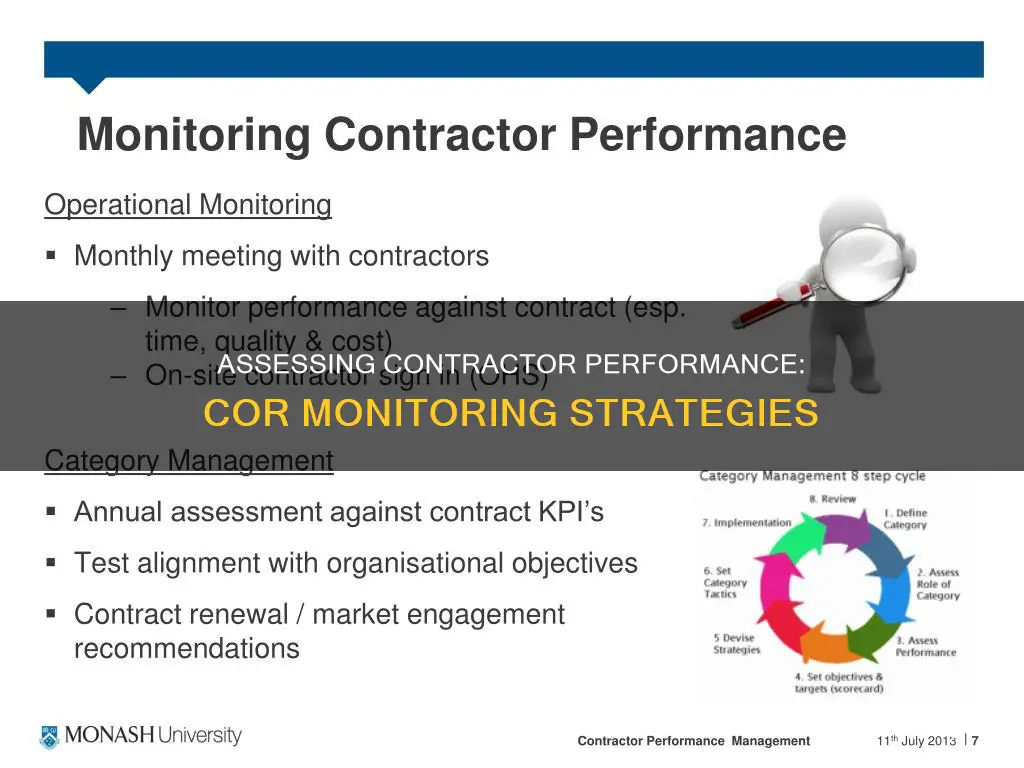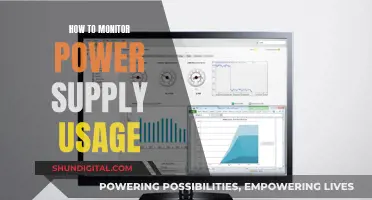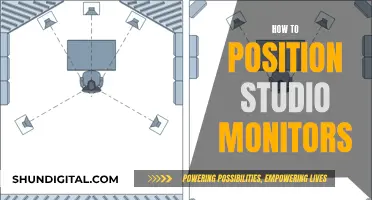
When assessing a contractor's performance, a Contracting Officer's Representative (COR) may conduct monitoring in several ways. These include reviewing progress reports, performing inspections through various techniques such as spot checks and random sampling, analysing contractor outputs, obtaining end user feedback, and reviewing invoices. The COR is responsible for ensuring that the organisation receives the expected quality and quantity of work from the contractor. The monitoring methods employed depend on factors such as the complexity of the work, the size of the job, and the expertise of those involved. Ultimately, the COR plays a crucial role in maintaining the success of the project or program by ensuring satisfactory contractor performance.
What You'll Learn

Progress or status reports
Information Requirements:
CORs should carefully determine the specific information needed in the reports to adequately assess the contractor's performance. This may include technical progress, problems encountered, upcoming challenges, staffing progress, licenses obtained, materials acquired, and the progress of subcontractors. It is important to communicate these requirements clearly to the contractor to ensure that the reports align with the COR's needs.
Reporting Frequency:
The frequency of progress or status reports should be established and communicated to the contractor. This reporting frequency should be outlined in the statement of work and included in the solicitation. It is important to find a balance between receiving updates often enough to effectively monitor progress and not overburdening the contractor with excessive reporting requirements.
Documentation and Communication:
CORs should maintain thorough documentation of their review of progress and status reports. This can be achieved by sending an email or memo to the contracting officer, outlining the findings and retaining a copy of the report in the contract file. Effective communication between the COR and the contracting officer is crucial to ensure everyone is informed about the contractor's performance.
Problem Identification and Resolution:
Progress and status reports are valuable tools for identifying potential issues or challenges early on. If problems are identified, the COR should work closely with the contractor to develop appropriate solutions and ensure the successful continuation of the project. This may involve adjusting the project plan, providing additional resources, or addressing any other concerns that may impact the contractor's ability to meet the contract requirements.
Comparison with Milestones:
Progress reports should be compared against established performance milestones to assess whether the contractor is on track. Timely completion of these milestones indicates adequate performance, while late or incomplete performance may indicate potential issues that require further investigation or remedial actions.
Quality Assurance:
In addition to monitoring progress, CORs should also focus on the quality of the work performed. This includes evaluating the number and quality of outputs, such as the number of repaired vehicles, students trained, or barriers installed. By comparing technical progress with resource expenditure, CORs can identify potential issues and ensure that the contractor is delivering the expected quality and standards.
By effectively utilizing progress and status reports, CORs can make informed decisions, address issues proactively, and ultimately ensure that the Department gets what it pays for through good contractor performance.
Best Place to Buy the Omron BP652N Wrist Monitor
You may want to see also

Actual inspection
The COR may perform inspections using several techniques and procedures, including spot checks, scheduled inspections of functions performed by the contractor on a periodic basis, random sampling of routine functions, and the use of contract monitoring and user reports. The COR must also ensure that the work performed under the contract is measured against the contract's performance requirements. If performance does not meet the requirements, the COR must identify deficiencies and advise the contracting officer so that remedial action can be taken before final payment and contract closeout.
The place of performance, type of contract, and kind of work required, each influence the feasibility of using inspection as the main tool for monitoring progress. The place of performance may make frequent inspections impractical due to insufficient travel funds or personnel. Additionally, while the US government has the right to inspect when it chooses, inspections must not be performed in a manner that unduly delays the work.
In some cases, 100% inspection may be warranted, such as when safety and health are a concern. Periodic, planned, or random sampling may also be used to inspect a limited number of parts to serve as a surrogate for inspecting the entire lot.
RMA an ASUS Monitor: A Step-by-Step Guide
You may want to see also

Site visits
The COR should develop a contract monitoring plan that is appropriate for the complexity and criticality of the contract. The COR should also determine the amount and level of monitoring required. For example, if a contractor's quality control program is consistently achieving a good level of performance, minimal monitoring may be sufficient.
The COR should also be mindful of the place of performance and ensure that frequent inspections are feasible. There may be practical considerations, such as the availability of travel funds or personnel, that impact the feasibility of frequent site visits.
Through site visits, the COR can directly engage with contractor personnel, ask questions, and make observations that provide valuable insights into the contractor's performance. This hands-on approach allows the COR to identify any issues or problems early on and take appropriate action to ensure the successful completion of the project.
Fertility Monitors: Can They Detect Infertility Issues?
You may want to see also

Contractor outputs
For instance, if the contract states that the contractor will provide a certain number of repaired vehicles, students trained, or barriers installed, the COR should monitor the quantity of these outputs. Financial status reports are often used in cost-reimbursement type contracts to monitor the contractor's expenditures and compare costs incurred with technical progress. Significant discrepancies between technical progress and resource expenditure can indicate issues with contract performance.
The level of detail required in financial reports depends on the type of contract, the nature of the work, and the method of payment. These reports are particularly important in cost-reimbursement contracts to determine the contractor's progress. The COR should also be aware of common errors in invoices, such as incorrect contract or order numbers, dates, vendor names, quantities, prices, duplicate billing, or incorrect submission locations.
Under cost-reimbursement contracts, the COR is entitled to question the reasonableness of costs and request additional information from the contractor if charges appear excessive. If the contractor fails to provide a satisfactory explanation, the COR should discuss the matter with them and, if necessary, consult with the contracting officer. While only the contracting officer may disallow costs, the COR plays a crucial role in monitoring and flagging problematic expenses.
Easy Guide: Hooking Up Multiple Monitors with a 1070 GPU
You may want to see also

End-user feedback
The primary focus of end-user feedback is to evaluate the timeliness and quality of the contractor's performance. Are the deliverables being provided within the expected timeframe? Is the quality of the outputs meeting the required standards? By seeking feedback from end users, the Contracting Officer's Representative (COR) can gain valuable insights into the contractor's performance and identify any areas that may require improvement.
Additionally, end-user feedback helps to determine if the end users' expectations are being met. Are they satisfied with the overall experience and the level of service provided? Are there any concerns or issues that need to be addressed? Obtaining this feedback allows the COR to make informed decisions and take necessary actions to ensure the contract is being fulfilled as expected.
It is worth noting that the need for monitoring can vary depending on the complexity of the work, the size of the job, the importance of the expected results, and the expertise of the contractor and government personnel involved. In some cases, if a contractor's quality control program is consistently achieving a good level of performance, the amount of monitoring can be minimal. However, when dealing with contracts supporting end users, their feedback becomes a crucial component of the monitoring process.
By actively seeking and considering end-user feedback, the COR can make more informed decisions and take appropriate actions to ensure the contract is on track and meeting its objectives. This helps to maintain a high standard of performance and deliver satisfactory results to the end users.
Cutting Off Ankle Tags: A Step-by-Step Guide
You may want to see also
Frequently asked questions
A COR, or Contracting Officer's Representative, is responsible for ensuring that the Department gets what it pays for through good contractor performance.
A COR can monitor a contractor's performance through various methods, including actual inspection, progress or status reports, milestone reviews, site visits, and creative monitoring methods such as the use of technology.
The need for monitoring is variable and depends on factors such as the complexity of the work, the size of the job, the importance of the expected results, and the expertise of the contractor and government personnel involved.







